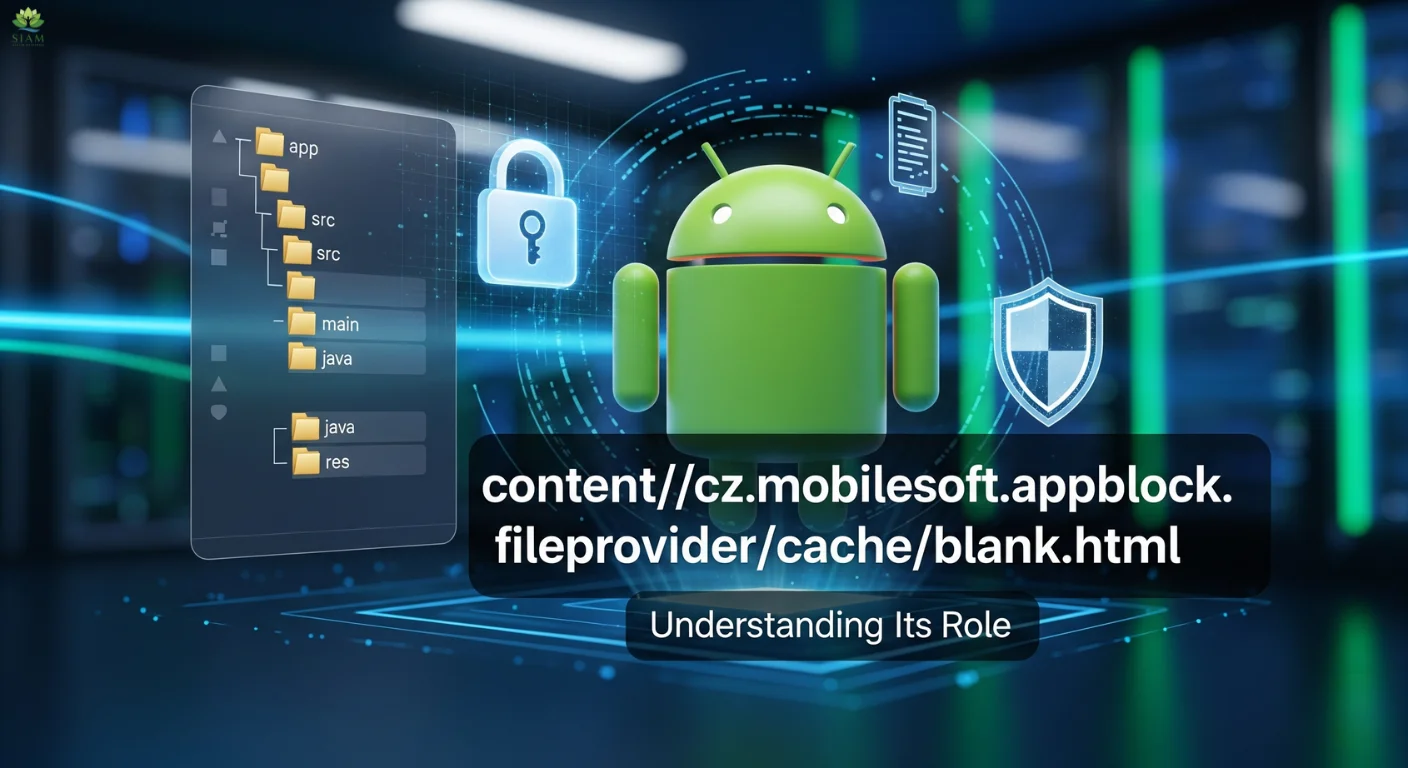When you delve into Android development, you often come across mysterious strings that can leave you scratching your head. One such string is content://cz.mobilesoft.appblock.fileprovider/cache/blank.html. While it may seem cryptic at first, this content URI plays a critical role in the Android content-sharing ecosystem. In this article, we will break down this URI and explore how Android uses it for secure file access, the benefits of using Content URIs over traditional file paths, and best practices for implementation.
Whether you’re an Android developer, a security-conscious user, or someone interested in modern Android development practices, this guide will provide insights into content://cz.mobilesoft.appblock.fileprovider/cache/blank.html and its significance in the AppBlock app’s architecture.
What is a Content URI, and How Does content://cz.mobilesoft.appblock.fileprovider/cache/blank.html Fit In?
Content URIs are part of Android’s content provider system, allowing applications to securely share data with other applications. Unlike direct file paths, which expose the underlying file system, Content URIs provide an abstraction layer for file access. This ensures that developers can control who has access to which files, thus improving security and performance.
In the case of content://cz.mobilesoft.appblock.fileprovider/cache/blank.html, the URI points to a cached HTML file used within the AppBlock app, a popular productivity application that helps users manage screen time and block distracting apps. The URI is an essential part of how AppBlock manages cached resources and user interactions with blocked applications.
Anatomy of the content://cz.mobilesoft.appblock.fileprovider/cache/blank.html URI
Let’s break down content://cz.mobilesoft.appblock.fileprovider/cache/blank.html:
-
Scheme:
content://identifies the string as a content URI, signifying it is not a file path but a secure reference to app resources. -
Authority:
cz.mobilesoft.appblock.fileprovideris the unique authority that identifies the AppBlock FileProvider. -
Path:
/cacherefers to the cached directory where AppBlock stores temporary files. -
Resource:
blank.htmlis the specific cached HTML file being accessed.
This structured approach provides a secure and efficient way for apps to share resources while keeping the underlying file system hidden from other applications.
Why content://cz.mobilesoft.appblock.fileprovider/cache/blank.html Matters for Security
One of the primary benefits of using Content URIs like content://cz.mobilesoft.appblock.fileprovider/cache/blank.html is the security they offer. Traditional file paths expose the file system directly, which could potentially allow unauthorized access. Content URIs, on the other hand, provide controlled access to resources through permissions that are specific to each app and file type.
Here’s how Content URIs improve security compared to traditional file paths:
By abstracting file paths and controlling permissions, Content URIs reduce the risk of unauthorized access and improve data sharing security.
The Role of content://cz.mobilesoft.appblock.fileprovider/cache/blank.html in AppBlock
AppBlock is a digital health and productivity app that helps users block distractions by managing screen time. Within AppBlock, content://cz.mobilesoft.appblock.fileprovider/cache/blank.html plays a critical role in providing a smooth user experience and optimizing performance.
Function of content://cz.mobilesoft.appblock.fileprovider/cache/blank.html in AppBlock’s Architecture
-
Blocking Interface: When AppBlock blocks an app or website, it needs to display a placeholder. content://cz.mobilesoft.appblock.fileprovider/cache/blank.html serves as this placeholder, ensuring the user is presented with a clean, non-disruptive screen instead of an error message.
-
Performance Optimization: The use of cached HTML allows AppBlock to load frequently used elements more quickly, providing a better overall user experience.
-
Resource Management: By caching HTML content, AppBlock efficiently manages temporary web resources, reducing the need to reload content from the network repeatedly.
This efficient caching system ensures that AppBlock is both functional and user-friendly while maintaining a high level of performance.
Technical Details of content://cz.mobilesoft.appblock.fileprovider/cache/blank.html and FileProvider Implementation
To understand how content://cz.mobilesoft.appblock.fileprovider/cache/blank.html works, it’s important to look at how FileProviders are implemented in Android. FileProviders are used to share data between apps securely by providing access to specific files through Content URIs.
Configuring the FileProvider for content://cz.mobilesoft.appblock.fileprovider/cache/blank.html
In AppBlock, the FileProvider is configured as follows:
<provider
android:name=”androidx.core.content.FileProvider”
android:authorities=”cz.mobilesoft.appblock.fileprovider”
android:exported=”false”
android:grantUriPermissions=”true”>
<meta-data
android:name=”android.support.FILE_PROVIDER_PATHS”
android:resource=”@xml/file_paths” />
</provider>
This configuration ensures that the FileProvider only allows access to resources defined within the file_paths.xml configuration file. By restricting access to specific directories, Android developers can control which files are shared and ensure that sensitive data remains protected.
Accessing content://cz.mobilesoft.appblock.fileprovider/cache/blank.html through ContentResolver
To access content://cz.mobilesoft.appblock.fileprovider/cache/blank.html, AppBlock developers use the ContentResolver:
Uri contentUri = Uri.parse(“content://cz.mobilesoft.appblock.fileprovider/cache/blank.html”);
try (InputStream inputStream = getContentResolver().openInputStream(contentUri)) {
if (inputStream != null) {
// Process the cached HTML content
BufferedReader reader = new BufferedReader(new InputStreamReader(inputStream));
StringBuilder htmlContent = new StringBuilder();
String line;
while ((line = reader.readLine()) != null) {
htmlContent.append(line);
}
// Use the HTML content as needed
}
} catch (IOException e) {
Log.e(“AppBlock”, “Error accessing cached content”, e);
}
This code allows AppBlock to read the cached HTML content securely and perform necessary operations with the file without exposing the file system directly.
Advanced Use Cases for content://cz.mobilesoft.appblock.fileprovider/cache/blank.html
While content://cz.mobilesoft.appblock.fileprovider/cache/blank.html is commonly used within the AppBlock app, there are several advanced use cases and integration patterns where Content URIs like this one can be leveraged.
WebView Integration with content://cz.mobilesoft.appblock.fileprovider/cache/blank.html
WebView applications can use Content URIs to load placeholder content during network delays or when there is a need for offline-first functionality. For example, AppBlock might use content://cz.mobilesoft.appblock.fileprovider/cache/blank.html as a fallback when a webpage cannot be loaded due to network issues.
webView.setWebViewClient(new WebViewClient() {
@Override
public WebResourceResponse shouldInterceptRequest(WebView view, WebResourceRequest request) {
Uri requestUri = request.getUrl();
if (“content”.equals(requestUri.getScheme())) {
try {
InputStream inputStream = getContentResolver().openInputStream(requestUri);
return new WebResourceResponse(“text/html”, “UTF-8”, inputStream);
} catch (Exception e) {
Log.e(“WebView”, “Failed to load content URI”, e);
}
}
return super.shouldInterceptRequest(view, request);
}
});
This integration helps provide a seamless experience for users, even when network conditions are poor.
Performance Optimization and content://cz.mobilesoft.appblock.fileprovider/cache/blank.html
Caching strategies are crucial in modern Android applications. Developers can implement various caching mechanisms, such as memory caching, disk caching, and network caching, to optimize performance. By using content://cz.mobilesoft.appblock.fileprovider/cache/blank.html for temporary content, AppBlock reduces bandwidth usage and speeds up content loading times.
Security Best Practices for content://cz.mobilesoft.appblock.fileprovider/cache/blank.html
When working with content://cz.mobilesoft.appblock.fileprovider/cache/blank.html, there are several security best practices to follow:
-
Limit Path Exposure: Always limit the directories that can be shared by configuring the
file_paths.xmlfile to only expose necessary resources. -
Use Granular Permissions: Grant specific, temporary permissions to apps that need access to your files, rather than providing broad access.
-
Validate Inputs: Ensure that all file requests are properly sanitized to prevent path traversal attacks and unauthorized file access.
By following these best practices, you can ensure that your use of Content URIs is both secure and efficient.
FAQs
1. What is a Content URI in Android?
A Content URI is a secure reference to a resource within an app that is shared with other apps via a content provider. It allows controlled access to app data without exposing the underlying file system.
2. How does content://cz.mobilesoft.appblock.fileprovider/cache/blank.html work in AppBlock?
This URI points to a cached HTML file that AppBlock uses to display a placeholder when blocking apps or websites. It also helps with performance optimization by reducing the need to reload content repeatedly.
3. What are the benefits of using Content URIs over traditional file paths?
Content URIs offer better security by abstracting file paths and controlling access permissions. They also allow for targeted file sharing and temporary, revocable permissions, improving both functionality and security.
4. How can I implement a FileProvider in my Android app?
You can implement a FileProvider by adding the necessary configuration to your app’s AndroidManifest.xml file and defining the shared paths in file_paths.xml.
5. What security best practices should I follow when using Content URIs?
Ensure that you limit path exposure, use granular permissions, and validate inputs to prevent unauthorized access or malicious activity.
Conclusion
Understanding content://cz.mobilesoft.appblock.fileprovider/cache/blank.html and how it fits into the larger Android content-sharing system is crucial for any Android developer or security-conscious user. By using Content URIs, apps like AppBlock can enhance security, improve performance, and provide a smoother user experience. As you continue developing Android applications, mastering the use of Content URIs and FileProviders will help you build more secure and efficient apps.
If you’re an Android developer, take the time to implement and configure Content URIs in your own apps. Not only will it improve security, but it will also optimize performance and create a better overall user experience.
Learn About Conjuguemos Live

Salman Khayam is a business consultant at Siam IT Solutions, specializing in digital marketing, PPC, SEO, web development, e-commerce, and email marketing. He designs custom strategies that deliver measurable success.


